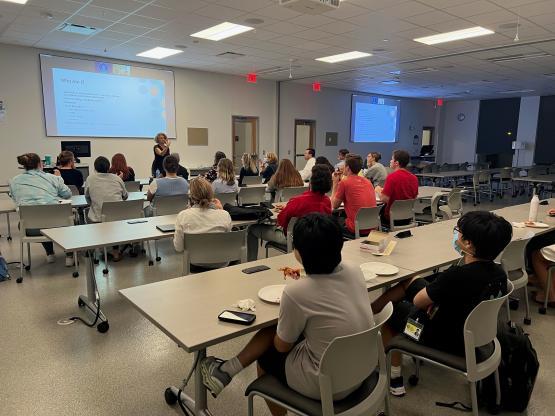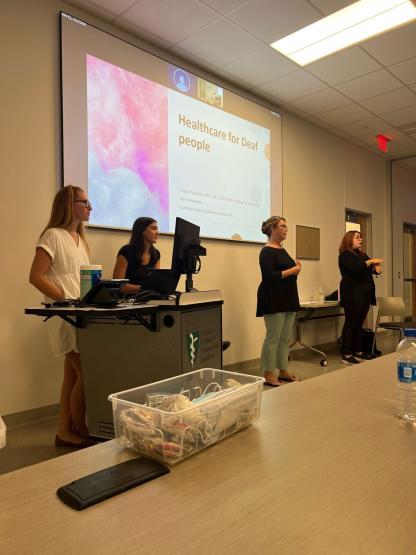
Students switch roles with deaf individuals at training event

During the height of the COVID-19 pandemic, Cheryl Prusinski’s husband underwent surgery. Unsure of the diagnosis, the couple waited anxiously at the hospital for results at the follow-up appointment. On this visit, the clinic did not provide an American Sign Language interpreter. Prusinski and her husband, who are both deaf, waited, becoming increasingly frustrated, the same frustration they’d dealt with repeatedly at health care appointments. Multiple times she requested a live interpreter be called, but the staff ignored her requests, told her to sit down and wouldn’t let her write, she said.
“I'm concerned about my husband and now we're waiting and waiting and waiting...” said Prusinski. “And I was so frustrated because I just felt like I didn’t have a voice, you know, I really wanted to scream.”
Eventually, the staff rolled in a computer with a Video Remote Interpreter (VRI), but the technology didn’t work. The staff refused to communicate with Prusinski, again ignoring her handwritten notes.
“The computer keeps freezing over and over. We don't understand what's happening. There's a total lack of communication.”
Next, a tech person arrived to troubleshoot, and when the VRI was functioning again, her husband was called for further testing. To make sure the interpreter didn’t break down, the tech person planned to accompany her husband. “And my husband was like, ‘Excuse me. No, I don’t want you in here. I need to undress,’” she recalls. “Now I can find the humor and the joke in it, you know, like ‘Oh my God... hearing people.’ But this happened so often.”
It’s situations like these in health care that inspired Jenna Barrett, OMS II, to develop Healthcare for Deaf Individuals, a unique program to provide Heritage College medical students an opportunity to expand their cultural competency among populations with different language abilities.
Barrett began taking sign language courses from Prusinski while earning a bachelor’s degree in communication sciences and disorders at Ohio University and became very interested in the Deaf community. However, it wasn’t until she became a medical student and was selected in 2021 as an Albert Schweitzer fellow that she identified there was a strong need for the health care community to better serve Deaf individuals. The Albert Schweitzer Fellowship is a prestigious national program for graduate and professional health students that requires fellows develop and implement a service project addressing social determinants of health.

The program Barrett created, Health Care for Deaf Individuals, was recently offered to Heritage College second-year medical students through the college’s Clinical Training and Assessment Center on the Athens campus. It included a role-reversal exercise using only ASL to communicate. Deaf volunteers posed as doctors while medical students pretended to be patients.
“This role reversal is meant to put medical students in the shoes of their Deaf patients in the future, to help them understand the frustrations they might face, not being able to communicate with their doctor,” Barrett said. “Oftentimes language and communication are Deaf peoples’ biggest barrier,” said Prusinski, assistant professor in the College of Health Sciences and Professions. “And receiving health care is the most important part of your life. Health care is critical. And so, you need access to communication [in a health care setting].”
Americans with Disabilities Act requires federally funded hospitals provide some form of translation services to deaf patients to ensure effective communications, so many providers rely on Video Remote Interpreters to translate for Deaf patients. VRI is less expensive than in-person interpreters, and because the cost of interpreters falls on providers, many choose the less expensive option.
Prusinski and Lori Woods, associate professor in the College of Health Sciences and Professions, agree that for a routine visit, the VRI is a great option. However, VRI can be problematic for many reasons that go far beyond technical glitches. VRI operates by using videoconferencing technology that connects an interpreter, often based at call centers around the U.S., with the provider and patient in the exam room. ASL has many regional signs that outsiders may not understand, the same way that spoken language has regional expressions. For example, the sign for hospital is different in Appalachia than it is in California, Woods explained.
“My brother has lived in the same rural area all his life. He absolutely knows ASL. He is fluent in the language,” Woods said. “He is fully capable of going to the doctor by himself. Well, when he showed up, there was a virtual reality interpreter, and he was completely lost. Like, sure, he could see her, this wasn't a technology problem, but he didn't understand her.” Woods explained that he left the appointment feeling confused and unclear about what his doctor had instructed him to do.
“For my brother, he needs to have a live interpreter. He needs to have somebody who is in this community, who knows how to communicate with him in ways that he understands,” she said.
According to a study published in Child Development, many deaf children experience language deprivation because the majority are born to hearing parents, whose first exposure to the Deaf community is through their infant and the medical community, which Prusinski says, sees deafness as something to be fixed.
“We will fix it through hearing aids, we will fix it through speech therapy, we will fix it through aural rehab,” she said. “They ignore sign language. It is often very oppressive."
Barrett believes the program she developed has potential to positively influence the quality of care Heritage College students will provide once they become physicians in part because they have the opportunity to interact one-on-one with members of the Deaf community.
“The training is a space for our Deaf community members to have a voice to the future doctors in this area—it gives them a platform to express their experiences and their issues with accessibility,” she said.
Woods and Prusinski, who participated in the program, are enthusiastic about the format of the training and feel that flipping the power dynamic of patients and providers in the exercise is a valuable experience to help students learn about the communication challenges Deaf patients encounter in clinical settings.
To better serve their Deaf patients, Cheryl urges doctors to schedule live interpreters for appointments and allow additional time for exams. She also suggests using simple wording when communicating through writing with a Deaf patient.
“Hopefully, the student doctors can become advocates in the future for accessibility and for their Deaf patients,” said Barrett.
